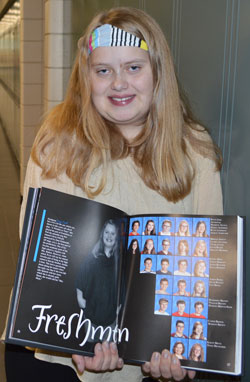When it comes to being on the high school yearbook staff, Avery Mutschler said he’s good with being someone who keeps track of the numbers. He’s helped monitor production costs, ad sales and the sales of yearbooks themselves since sophomore year.
But when he learned last year that he was going to have a hand in designing his school’s annual signature-laden chronicle of grades 9 to 12, Avery recalled that he and his fellow “finance guys” group didn’t have much confidence about the process.
“We were terrible. We were the four dudes who didn’t know how to design stuff,” Avery said. “We just thought, ‘The girls are going to be more creative and artsy thinking.’ But (adviser Cari) Slot was like, ‘Even people who don’t think they’re creative can do this.’ And by the end of the challenge, it was cool to have had such a variety of ideas, and everybody just knew what the direction was.”
The finance guys even sold one of their ideas to the other staffers and a group of students they surveyed: a military tribute page that honored adult staff who served in the armed forces, and students who planned to.
“People thought it was a really cool idea,” he said.

Still a Thing
High school yearbooks have been and are still a thing.
Slot said that at Lowell, like most U.S. high schools, freshmen and seniors are more prone to buying than are sophomores and juniors, since the middle grades aren’t considered milestones as much as ninth and 12th.
“It’s always worked,” Slot said, “but our challenge has been, how do we design something that will better satisfy the needs of all 1,200 of our students?”
The yearbook, and the process to design it at Lowell High School, has undergone its own makeover. The results will be seen next spring when it’s published.
Last year, Slot took student staffers through the design thinking process. The goal: to create a yearbook that represents the entire student body.

Design thinking creates a mindset for people to innovate. The process includes talking with customers — in this case, yearbook buyers — to understand what they want; defining financial, creative and logistical challenges to meeting those needs; brainstorming; building prototypes; going back to users for feedback; and finally, making it happen.
“Now we’re very customer oriented,” Slot said. “The yearbook costs $65,000 to $75,000 to produce every year, so we treat this like a business — a business we want to succeed.”
Last year and this year, students were placed in groups and charged to come up with a yearbook theme and cover, as well as prototypes of a couple pages. A panel of three adult judges rated elements of each plan according to design-thinking strategies.
Yearbook Editor Abby White said parts of every plan were used in last year’s yearbook. Design thinking, she said, “really helps get ideas flowing.”
















